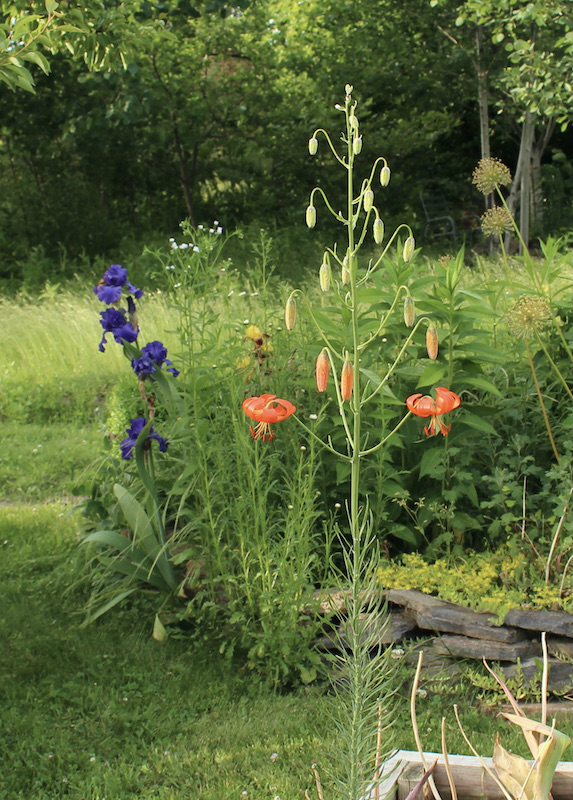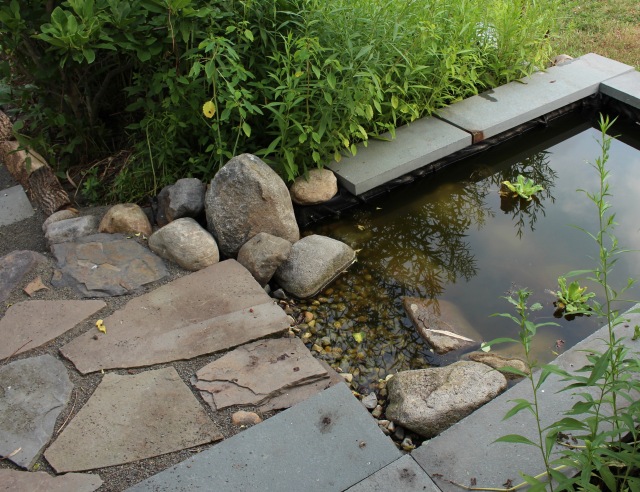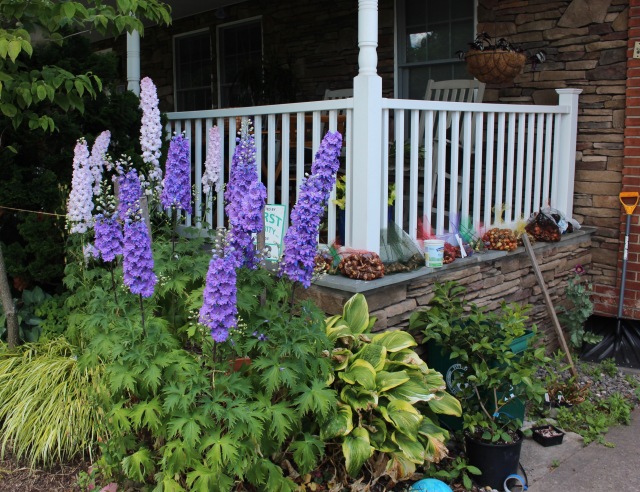I’m watching the weather radar with my fingers crossed for some rain tonight. Its the typical summertime story for gardeners, where everyone else is hoping for another day of blue skies, while we’re sitting here hoping for a completely washed out day (or if it’s not too greedy, night, followed by a day perfect for weeding and planting but…). Things are’t too bad, but there’s some heat on the way and without a little rain the garden will start complaining. As it is the lushness has been sapped out of the lawn and the shade plantings are wilted, but to be honest I blame greedy maple roots for most of that.

It’s an oxeye daisy year in the front border. Winter killed off much of the fennel, and the daisies appreciate the open real estate. It’s not a fancy look, but still better than more yawn to mow.
A few plants don’t mind, in fact prefer, the drier soils. Here are a few of the more interesting things popping into bloom and looking quite good while they do it. Thing one is this red Echium.

Last year at the NARGS Ithaca plant sale I picked up an Echium russicum seedling and was a little unimpressed as it tried to flower amidst the lush chaos. This year I’m loving its look in the sparseness of a drier flower bed.
The milkweeds always put on a decent show, and I wouldn’t complain if more show up, although one clump of the common milkweed is plenty… which of course doesn’t explain clumps two and three and four throughout the garden.

Common milkweed (Asclepias syriaca) is a weed not suitable for the cultivated garden. I like the fragrance though, and don’t mind pulling up every sucker which pops up in a 20 foot radius… every week… After bloom finishes I’ll cut them back to about 1.5 feet and the new growth will attract the Monarch butterflies.
The purple milkweed (Asclepias purpurescens) is quite showy and quite a responsible flower border inhabitant. This one hasn’t run around for me like it’s common cousin, and I actually may have to dig and divide it in order to spread it around. That will be a new one for me and it makes me a little nervous since to get this one going took a few failed seed attempts and then quite some nursing along before the clump flowered for the first time. Sadly I have yet to get a seedpod on this one.

Asclepias purpurascens, the purple milkweed. Nice form and foliage and doesn’t mind a little bit of a dry spell, unlike it’s similarly colored swamp milkweed relative.
Another cool new thing in the purple color family is this knapweed. I don’t like the most aggressive roadside-weedy ones, but this well-behaved perennial with the purple topped knobby buds is worth growing. I was so excited to find it through Nan Ondra’s Hayefield Seeds. If you haven’t already visited her site you should, the summer seeds are ripening and going on her list, and now is a great time to scatter them about for when the summer rains come (they will either sprout now or wait until cooler weather returns).

Centaurea atropurpurea, the purple knapweed. Purple flowers poke up from scaly flower buds, and they’re quite popular with the bumble bees.
The knapweed seed was sown last summer and is blooming now, but the next plant has been inching along for at least 6 years. Three small bulblets came in a ziplock bag with a note that they should be hardy for me, but I’ve heard that song before. They were planted in a couple spots, one died the first winter but the rest slowly grew and grew until suddenly this week I had a flower stalk appear. Honestly I was only just last week cursing the bulbs, because seriously I know it’s not the nicest garden but how long are we going to drag this out, and then all of a sudden a stalk and flower were there. It’s my first blooming of the Orange River lily (Crinum Bulbispermum) and I’m not at all annoyed that it was the smaller bulb which bloomed and the larger bulb is still just sitting there pretending to be exotic.

Crinum bulbispermum, a plant which may need to be beaten with a water hose to induce blooming since that’s what our contractor did to it… and the un-beaten plant is still just foliage.
Someone might remember I planted a few other, less-hardy Crinum lilies last summer, and shockingly they all survived with only some pitiful attempts at additional winter protection (I threw a bucket over them in January one cold night when I was feeling guilty about spending a bunch of money and not protecting them better). Those bulbs are far less-likely to flower this summer since they all appear to have lost much of their bulbs to the cold, but maybe next winter will be different? Maybe I’ll mulch and cover them and give them what they deserve? Maybe…

The lighter blooms darkened up by the end of the day to the typical Crinum bulbispermum color. I like them, even though I suspect they’ll be finished flowering by the end of the week. These bulbs by the way receive no winter protection and have been perfectly hardy to just under zero Farenheit.
So is three as far as interesting things go here? On to more mundane things. I think I will give up and rip out the tomatoes poisoned by the herbicide-laced grass clippings mulch from next door. They are all still sending up stunted, curled and twisted foliage and one plant is beginning to brown and die so I don’t think there’s much of a chance for any miraculous recovery. New plants are in the next bed over and although I nervously mulched them with grass clippings from my own yard, they’re still doing fine, so I guess eventually there will be tomatoes for sauce this summer.

The sad, stunted tomatoes. I haven’t noticed any damage in other plants, although some of the larkspur in this bed might be stunted, and thankfully the cabbage/cauliflower bed also looks fine in spite of getting the same mulch.
I’m wondering if it would be weird to fertilize the lawn and water it just so I can mow it and bag the clippings to put down as mulch in the vegetable garden? I guess it wouldn’t be much different than a hayfield that gets cut, and it’s still better than bagging the clippings to dump them in the trash, but maybe I should just work a little to keep the weeds down. Nahhh. Mulch is better, plus it conserves moisture and the earthworms eat it up and produce worm-manure all while aerating the beds with their worm-tunnels. It would just mean more lawn mowing, which in theory I am against 😉

The meadow garden where mowing is still a no-no. It’s drying out so tans are starting to show up. There’s some rudbeckia opening, but the white is nearly all Erigeron anuus, the annual fleabane. It’s an awesome weed for me and I let it grow wherever it wants, and I don’t think it’s greedy to hope for a blue or pink seedling to show up.
Tomorrow I’m repairing brickwork so that new siding for the addition can come right up to the old construction, where the bricks were pulled down. I’m not a mason, so hopefully it turns out good enough that nobody notices my mistakes, but the reason I’m doing it is so I can move on to powerwashing the deck and moving deck pots into position. Then I can re-do the drip lines and then hopefully no more hand watering the pots this summer. It will be nice finally getting the deck clean and ready for summer since it’s been somewhat neglected with all the debris out there and the mess. I sat out there on one of the chairs this afternoon and finally moved because a stupid wasp kept buzzing in my ear. That’s when I noticed the other wasps and turned the pillow over to find the nest I was sitting on. Hmmm.
It’s still not raining. There are downpours to the East and downpours to the West but nothing here so I hope tonight’s not a bust. In any case it’s still better than a February polar vortex 🙂
















































































